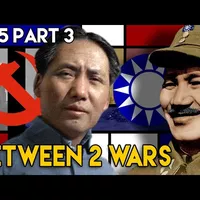Communist Boots Are Made For Walking - Mao‘s Long March | BETWEEN 2 WARS I 1935 Part 3 of 4 - YouTube (2)
the Nationalist Army crushed nine Communist divisions, forcing their way into Jiangxi.
The communists are driven from the province, and local Kuomintang governments are set up
under oversight of the Nanchang Headquarters. Chiang did it. He has consolidated his power,
and his principal rival is now driven from his new National China.
Or? Yes, Mao and the Communists lost their Jiangxi Soviet, the basis for their Communist
Republic of China. But Mao wouldn't be Mao if he hadn't applied his strategy of Mobile
Warfare to the Nationalist push. The Communists might have been defeated, but they are not
destroyed.
In October 1934, Mao's evacuation from Jiangxi Province begins. The communists head north,
avoiding any big confrontation with the NRA. Slowly but steadily, throughout 1934 and 1935,
hundreds of thousands of Communist soldiers- men, women and children make their way to
an enclave in the Northeast of Shaanxi province. This will become known as the Long March,
although it is more accurately described as a series of smaller marches made by multiple
groups with many stops in between. Though Mao would use the Long March to build
up and ‘eternalise' his own character and the Communist movement to reach legendary
proportions throughout his life, the Long March is a costly undertaking which doesn't
lead to immediate stability by any means. Thousands die on the way of starvation or
at the hands of locals, Nationalist soldiers or their sympathizers. At the same time, the
communist armies plunder and murder anyone who stands in their way. And though the Communists
have managed to flee the direct control of Chiang Kai Shek's Kuomintang Government
in Nanking, Chiang hasn't given up on the idea of eradicating the Communists.
And let's also point out that the Long March takes Mao and the CCP to the Northern corner
of China, dangerously close to Manchukuo, a puppet regime set up by Japan after the
invasion of Manchuria in 1931. Who know what Japan is planning for the future... I mean,
China is much more abundant in natural resources and fertile lands for the production of food,
something the Japanese government and armies really need now that the global market is
becoming harder and harder to rely on, so Japan is looking outward.
So, where is China in 1935? The United Front from before the White Terror is but a historical
dream. The communists are hunted, driven from power and Chiang has not given up on his dream
of destroying them. They are holed up in the north, protected by their Mobile Warfare tactics
and hidden from the short-ish arm of the central government of the Kuomintang.
But what will happen if the Japanese ever decide to invade? Will they face two different
armies, one of the Chinese Nationalists under Generalissimo Chiang Kai Shek and the other
one being Chairman Mao's Communist Red Army? Who would still be fighting each other? And
what will the Soviet Union do? They are ideologically connected to the Chinese Communists but are
also engaged in a long Border dispute with Japan. One thing is sure, though. The chances
of a peaceful resolution of the Chinese conflicts are zero.
If you would like to find out more about how Japan became increasingly expansionist in
the interwar years and how they invaded Manchuria in 1931, you can click here for our episode
on that [point], any moment now. Our Patron of the week is Carl Ford. Thanks to Carl,
we are one step closer in our struggle to revolutionize the world of Historical Documentaries.
Do your part and support us on Patreon! Subscribe, ring that bell…
…and remember. Every long journey starts with one small step.

